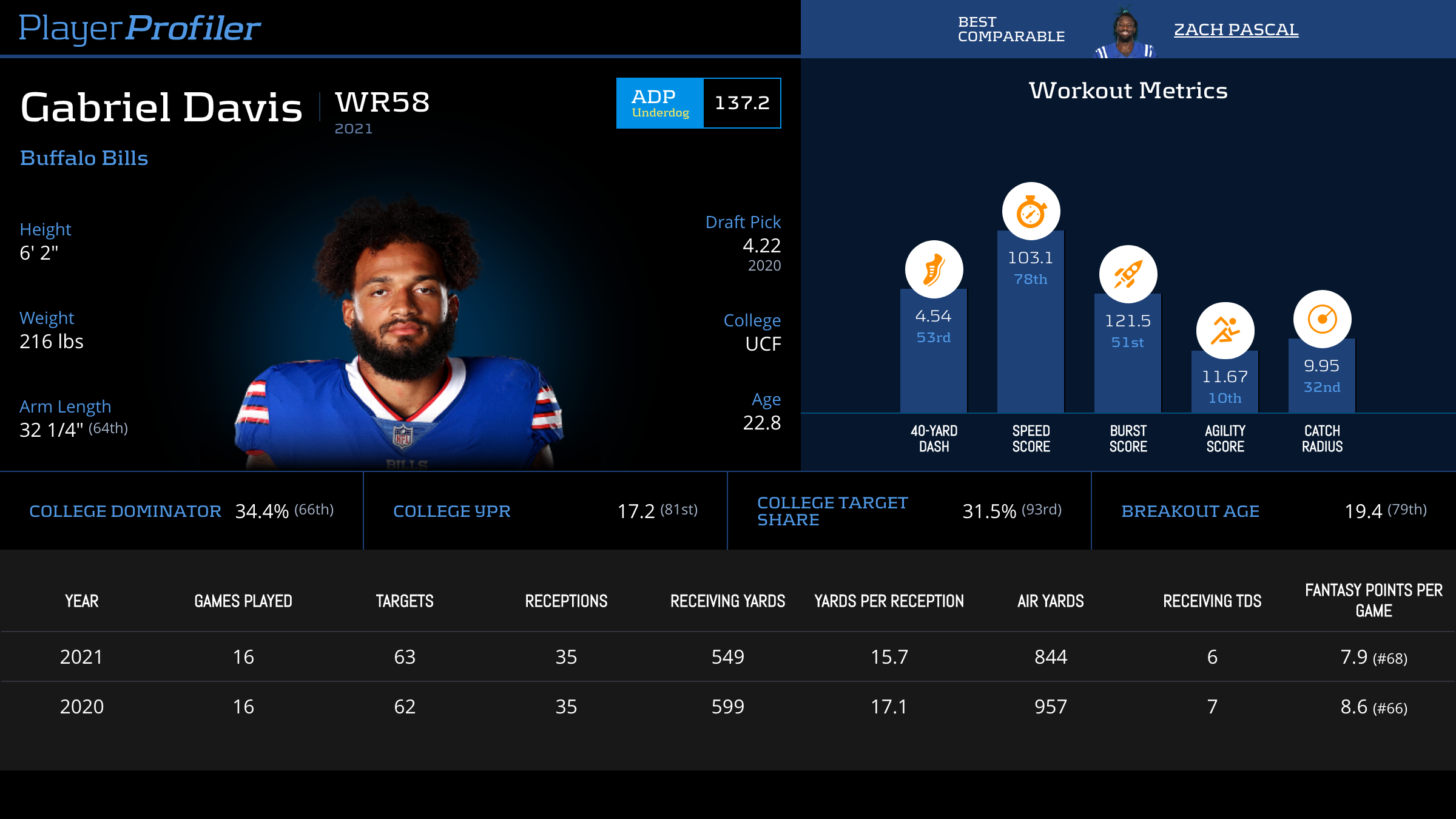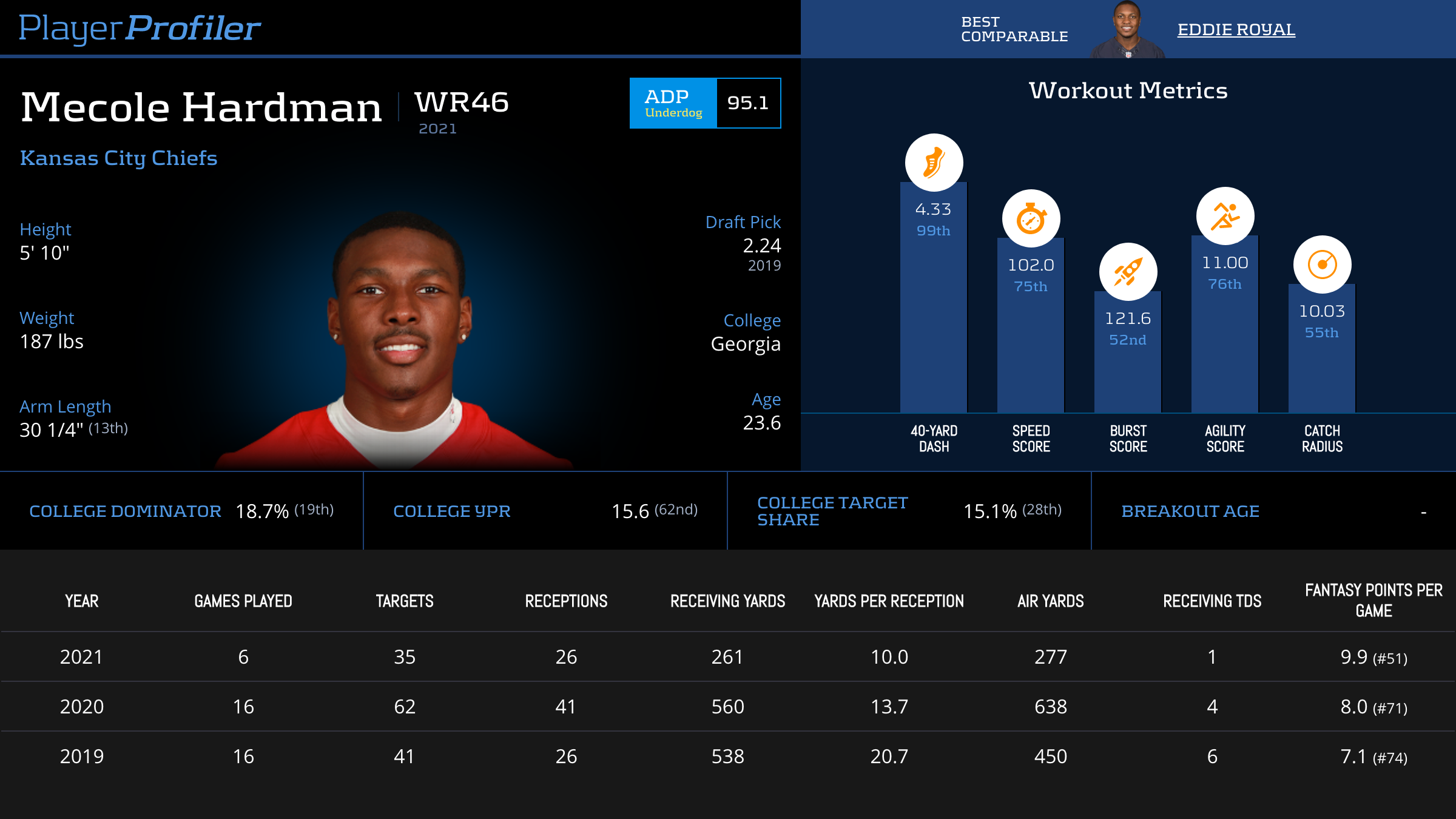Every day on twitter dot com seems like it’s a new “day” allotted to a given player. But some options seem to have their time in the sun more often than the rest. This series is for them, Introducing: The Most Polarizing Players in Fantasy
In my Thinking About Thinking Column, I regularly discuss ranges of outcomes and the benefits of humility-based drafting. In a game where only one of twelve players win, it is beneficial to take shots on players with a wide band. As we transition into best ball season this only becomes more important.
Last year I wrote an evergreen series applying lessons from DFS tournaments to best ball tournaments. A key theme of the series was being open to low-probability results, and targeting high-ceiling archetypes. While everyone can agree on the ceiling of a Ja’Marr Chase or Justin Jefferson, the next tier of ascending star is less easy to spot. For that reason, several young players are viewed as over-drafted by some, and superstars in waiting by others.
Introducing: The Polarizers
This series takes an open-minded view of the most polarizing players in the 2022 fantasy landscape. To the extent I have a stance on these options as a group, it is that young, wide-band players are the archetype we should be drafting. Our priors regarding each specific player should only account for so much. To phrase this in terms of a heuristic:
The extent to which our prior should inform our willingness to draft a player at cost, should be tied to the extent in which we can have a high degree of confidence in those priors.
In other words, we caution against being overly dismissive of players we do not have enough information on to dismiss. Every single player I profile in this series, in my view, has a plausible ceiling. By the same token, each of them have significant risk factors in reaching that ceiling or securing a floor. This wide band is why they’re so often in the forefront of the discourse. So let’s dive in to understand the range of outcomes, and try to define the ceiling and chance to achieve it.
The Polarizers: Gabriel Davis
Our first case study is a man who posted possibly the most impressive single game of any wide receiver in 2022. However, the owner of the infamous 8-201-4 line in the playoffs ran less than half his team’s routes in 2021. Can the talented 23 year-old convert his promise into fantasy production in his third year? That’s what we’ll discuss today.
Gabriel Davis: Rorschach Wide Receiver
There are two schools of thought regarding Davis’ profile as he enters 2022. One is based primarily on his season-long stats which are entirely unimpressive. Davis’ 10.9-percent target share, and 7.9 PPR points per game hardly portend a breakout season. Combine his limited production with his day three draft capital and it is easy to see the basis for skepticism of Davis.
However, there is another school of thought which lends more credence to Davis’ possible ascension.
For most of 2021, Gabriel Davis was a part-time player for the Bills. He never surpassed 52-percent of snaps until week 14 due to an Emmanuel Sanders injury. From that point forward he served as Buffalo’s clear number two receiver. This was a role he would not relinquish when Sanders returned. We all know of Davis’ nuclear divisional game, but the former UCF Golden Knight was also good for 13.6 PPR points per game in the five contests he played a full-time role prior to his explosion. While hardly a breakout star, this mark would have placed him at WR30. This is just behind his underdog ADP of WR26.
Can Davis hit that level of production or surpass it?
‘Targets are Earned, Routes are Given’
For the remainder of this article I will primarily be focusing on Davis’ per-route stats. This is because before we assess the likelihood of circumstances breaking in the favor of a player like Davis, I think it’s crucial we analyze his realistic ceiling is if they do.
I often use the phrase “targets are earned, routes are given” to describe the essence of my wide receiver data analysis. Players such as Davis who have provided spikes in production when granted opportunity are often placed in a similar category as those offer high efficiency when targeted, but draw few targets on their routes.
There is a difference between betting on the efficiency of a player to earn them more targets within a stable role, vs. expecting a player who earns volume on their routes, to eventually run more routes. For example, Davis had a target rate of 22.2-percent, and yards per route run of 1.93 in the 2021 regular season. Let’s compare that to the 16.7-percent and 1.38 marks respectively of his teammate Dawson Knox.
If I were to bet on a Buffalo passing option taking a big step forward n 2021, it would certainly be Davis over Knox. Knox’s nine touchdowns brought him into the TE1 conversation. However, there is much less room for organic growth in his profile. He has already maxed out the efficiency of his targets ranking No. 8 in yards per target, No. 2 in touchdowns, and No. 4 in target accuracy at the position. Already running over 75-percent of routes, Knox needs to improve his target earning capacity within the role he already has.
Meanwhile, Davis can increase his production almost twofold, simply by running more routes and continuing his per-route pace.
Lost in Translation: Projecting Target Carry-Over when Routes are Increased
I am more inclined to buy into a player like Davis vs. receivers of the high efficiency / low volume mold such as Allen Lazard because targets are sticky. As demonstrated in the tweet below from Santiago Casanova, target share year over year becomes remarkably stable from year four onward. Davis has the chance to join players such as Tyreek Hill and Chris Godwin as part-time youngsters who made massive leaps in their first three years when given a full-time role. However, while comps like these exist, there are far more cautionary tales than success stories in the annals of extrapolation history.
We know target share is consistent by WR, but when can we expect it to "stick"?
Turns out that we can expect target % to be within 2% of career average after ~40 games and within 1% after ~72 games.
40 games are midway through a third season if games are played consecutively pic.twitter.com/mJAH6JWX51
— Santiago Casanova (@BrotoFFCasanova) December 6, 2021
Why do Per-Route Stats rarely Translate to Full-Time Roles?
Many in the camp of prioritizing target share over per-route samples point to the higher correlation of target share to fantasy production and greater stickiness year over year vs. targets per route. While I do think per-route stats provide valuable signal there are reasons why not all targets translate when routes are added.
There are three general reasons per-route target translations often fail to materialize into fantasy production.
Rational Coaching
The first is simple; coaches are generally good at evaluating their players. Failing that, their previous actions are good predictors of their future actions.
Essentially, if a coach is giving a player only a part-time role, it is likely the player either is best used in that role. If not, and he is indeed misused, he may continue to be misused nonetheless. In cases such as this, players with consistently impressive opportunity stats, but limited total stats, may never gain enough opportunities to translate whatever capacity they have. A common example of this is slot receivers who come off the field in two wide-receiver sets. They earn a high number of targets when in the formation, but are systemically blocked from playing in all situations.
Selection Bias
The second example is based on selection bias. This means a given sample is inherently biased toward a given result, thus failing to represent a typical, random sample. In this circumstance, a player who sees a high portion of schemed targets is unable to translate their per-route target rate when granted a full time role. By schemed targets I mean targets in which no other player is a viable option on the play. Therefore, the target is not ‘earned’ once the play is called. These would include shovel passes, screens and the like.
Put yourself in the mind of a coach, for example Andy Reid. 33-percent of Mecole Hardman‘s 2021 targets were behind the line of scrimmage: several on these ‘schemed target’ plays. Clearly, putting the ball in the hands of Hardman is a priority for Reid. Reid was rewarded by outstanding efficiency on these touches. However, Hardman – despite his electricity with the ball in his hands – has been a limited player, and thus ran only 53-percent of routes. If Hardman did run 100-percent of routes, should we really expect his targets to scale at the same rate?
In this case, we should not. It is illogical to expect Reid to call double the number of screens for Hardman when giving him a route increase. The routes Hardman runs are already tied to the number of plays Reid wishes to scheme the ball into his hands. Any additional routes Hardman runs at the expense of more ‘traditional’ receivers may be less likely to result in a target than his existing sample of routes.
Small Sample Variance
The last reason is the least interesting, and least systemic. If we are dealing with a player running half the routes, the sample of their targets earned per route is by nature more volatile than a player running every route. This certainly makes a given metric less reliable, but not in a directionally predictable fashion.
Why Gabriel Davis May be the Exception
Let’s consider the systemic factors working against route translation analysis. According to Pro Football Focus, just four of Davis’ 70 targets were behind the line of scrimmage. As well, 68-percent of his snaps were out wide rather than in the slot. Recall from the beginning of the article, we already have a six-game sample of Davis as a full-time player. In that stretch Davis posted a 21-percent target share, playing over 80-percent of snaps in each game.
The systemic risk factors to translating the per-route target rates of part-time players do not apply to Davis. He profiles as a prototypical, field-stretching outside receiver, albeit not one likely to dominate targets to the degree of Stefon Diggs.
Doubting Davis’ likelihood to take on the starting boundary receiver role early in the off-season was a fair concern. However, free agency and the draft have passed, and the only Bills additions were Khalil Shakir and Jamison Crowder. Both players are replacing the losses of Cole Beasley and Emmanuel Sanders. Luckily for Davis, neither profiles as the split-end receiver Davis is. We should have confidence in Davis as a full-time option in 2022. The question is how high of upside he presents in that role.
What is the 2022 Ceiling?
Following a similar process to mine, Dwain McFarland posted the below series of tweets regarding his late-season role.
When comping him to other Year 2 and Year 3 players with similar TPRR/YPRR/PFF Rec Grades the list isn't too pretty though since 2011:
Darius Slayton, James Washington, Devin Funchess, Torrey Smith, Rueben Randle, Jermaine Kearse 🫢
— Dwain McFarland (@dwainmcfarland) May 12, 2022
As McFarland shows, Davis is likely to be a fantasy factor in 2022 without any improvement in target earning capacity. The issue however, is his list of comparables dictates a possibly limited ceiling even in that case. (Note: Davis’ receiving grade is 80.0 (elite) including the playoffs vs. 72.1 (above average) using only the regular season)
Casting further doubt on the potential payoff of Davis are his win rate stats as tracked by PlayerProfiler. The Bills receiver ranked No. 67 in route win rate, and No. 54 vs. man coverage.
Nonetheless, I wanted to cast as large a sample of comparables as possible based on his expected market shares with a full-time role. I also wanted to outline a ceiling case for Davis, a young player who may ascend in talent as well as opportunity this year. If he hits, how impactful is the hit?
In order to gather an idea, I charted every receiver within a 2.5 percentage point delta of his target rate (between 19.7-percent and 24.7-percent), and an average depth of target greater than 10.0. The later filter was to exclude the systemic errors in route translation discussed earlier. I also excluded all players with less than 200 routes run.
Interesting observations:
- Of 89 players over the past five years within these parameters, as well as over 75-percent route participation, 18 (20-percent) had greater than 15 PPR points per game. Of those, 37-percent had at least 13 per game.
- When examining just the last two years, 39-percent of the aforementioned sample scored greater than 15 PPR points per game.
- Among the 89 receivers fitting the above criteria, 19 played in top eight (25-percent) scoring offenses. Those 19 averaged 14.7 PPR points per game – the WR20 mark in 2021.
- Of the full sample, 77-percent of receivers had a route participation of 75-percent or greater. (89 of 116)
These observations have mixed inferences for how I view Davis. On one hand, most of the players in his archetype are failing to provide meaningful fantasy value. However, when factoring in the expected value of the Bills offense, his projection looks much stronger. As well, it should be considered encouraging that over three in four players of this archetype are running 75-percent or more routes. This backs up my hypothesis that Davis does not profile like a typical part-time receiver.
To Buy or not to Buy?
Gabriel Davis currently sits with an ADP of WR26 in best-ball and WR42 in dynasty. This is an interesting dichotomy for a 23-year-old receiver. In fact, I intend to feature Davis in a column to come examining inefficiencies between seasonal and dynasty ADP. However, on the whole, I would expect him to be much closer to WR26 than WR42 in 2022. Projecting his role forward in the Bills offense puts him on track to be a backend WR2 this upcoming season.
However, several of the names appearing among the 19 receivers in those elite offenses have shown much higher talent ceilings than Davis as a player. This list includes Ja’Marr Chase, Tee Higgins, Tyler Lockett, Tyreek Hill (multiple times), Brandin Cooks, and other pro-bowl-level talents. Because Davis may be being buoyed more by role, situation, and projection than proven talent, it makes sense his dynasty ADP lags his seasonal value even as a young player. Nonetheless, should he show greater improvement in 2022 and realize his ceiling there is little doubt his dynasty price will immediately skyrocket.
Other Options
If I were to make a definitive call, it’s that Davis has a fairly high-risk profile, but limited projectable payoff beyond his WR26 price tag in best ball. I prefer options such as Terry McLaurin, Allen Robinson, Courtland Sutton, Jerry Jeudy, Elijah Moore, Darnell Mooney, or Juju Smith-Schuster. Each of these is similarly or lower-priced, and either plays in a similar offense with more proven potential, or has vastly outperformed Davis on a per-route basis. Even in seasonal leagues, I am hesitant to buy players on the basis of favorable situational elements baked into their cost.
However, in dynasty I am more willing to take a shot. The value proposition on Davis’ profile at his age and expected 2022 production is strong vs. his reduced cost.
The Final Word
There is no doubt Gabriel Davis will be one of the most discussed players in 2022 regardless of result. Interestingly, I come away from this feeling he should not be as polarizing as he appears. Seemingly locked into the WR2 chair on an elite offense, I struggle to envision a massive bust. However, his limitations as a receiver portend a WR2/WR3 finish is more likely than a WR1 breakout. Think along the lines of Marvin Jones, DeVante Parker, or Mike Williams. The latter’s 2021 breakout is a potential ceiling case for Davis in a similar role within an equally potent passing game.
Davis’ youth, role shift, and demonstrated weekly ceiling make him a wide band archetype in theory. However, I think it more likely his career plays out with greater variance week-to-week than season-to-season moving forward. Before I’d pound the table on buying or selling, I would instruct you all to consider touching grass before your next hours long argument on “Gabriel Davis Day.”





